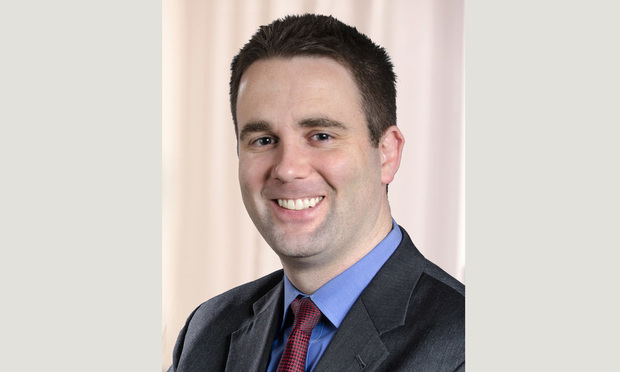Sixth Circuit Grants Rare Petition for Rehearing En Banc in Abortion Case
The order granting rehearing means the Sixth Circuit will decide a case involving the hot topic of abortion in the upcoming election year. And, no matter which way the case is decided, it means the U.S. Supreme Court will likely face the prospect of another cert petition in an abortion case the near future.
January 13, 2020 at 10:00 AM
9 minute read
 Conor B. Dugan, Warner Norcross + Judd
Conor B. Dugan, Warner Norcross + Judd
The U.S. Court of Appeals for the Sixth Circuit recently granted a petition for rehearing en banc in a case involving a controversial Ohio abortion law. The order granting rehearing means the Sixth Circuit will decide a case involving the hot topic of abortion in the upcoming election year. And, no matter which way the case is decided, it means the U.S. Supreme Court will likely face the prospect of another cert petition in an abortion case the near future.
 The case, Preterm-Cleveland v. Himes, No. 18-3329, involves Ohio law H.B. 214, which prohibits providers from performing abortions on a woman if the provider knows or has reason to know the woman is seeking the abortion because the unborn child has Down syndrome. It does not criminalize the conduct of the pregnant woman. Crucially, the law criminalizes the abortion provider's conduct no matter the stage of pregnancy. In other words, the law applies to pre-viability and post-viability abortions.
The case, Preterm-Cleveland v. Himes, No. 18-3329, involves Ohio law H.B. 214, which prohibits providers from performing abortions on a woman if the provider knows or has reason to know the woman is seeking the abortion because the unborn child has Down syndrome. It does not criminalize the conduct of the pregnant woman. Crucially, the law criminalizes the abortion provider's conduct no matter the stage of pregnancy. In other words, the law applies to pre-viability and post-viability abortions.
After the passage of H.B. 214, a variety of abortion providers sued the Ohio officials responsible for its implementation in the U.S. District Court for the Southern District of Ohio. The plaintiffs argued that H.B. 214 unconstitutionally barred pre-viability abortions based on a woman's reason for seeking out the abortion and moved for a preliminary injunction, which the district court granted.
Quoting the U.S. Supreme Court's 1992 decision in Planned Parenthood of Southeastern Pennsylvania v. Casey, 505 U.S. 833, the district court held "federal law is crystal clear" that states cannot prevent a woman from "making the ultimate decision to terminate her pregnancy before viability." Because H.B. 214 did just that, the district court held that it "violates the right to privacy of every woman in Ohio and is unconstitutional on its face." Accordingly, the district court preliminarily enjoined the implementation and enforcement of H.B. 214.
The defendants appealed. They argued the Sixth Circuit should "reverse the district court's decision because the district court applied an erroneous legal standard by creating an 'absolute' or 'categorical' right to a pre-viability abortion." The defendants argued the preliminary injunction should not have been issued because the state of Ohio had "compelling interests in protecting those with Down syndrome, the integrity of the medical profession, and the Down syndrome community and its civic voice."
The defendants also attempted to argue Roe v. Wade, 410 U.S. 113 (1973) and Casey only barred abortion restrictions pre-viability where the asserted interest involved the woman's health and potential life. Here, because the state was "asserting an interest in preventing discrimination," Roe's and Casey's categorical prohibition on pre-viability abortions did not come into play.
In a split decision, the Sixth Circuit rejected the defendants' arguments and affirmed. The Sixth Circuit held the right to terminate a pregnancy before viability "is categorical." In other words, according to the Sixth Circuit there is an absolute right to abortion pre-viability.
Nor did the panel find the defendants' attempts to distinguish Roe and Casey persuasive. The court wrote: "To give credence to the argument that an interest such as preventing discrimination or stigma may lay outside the interest in potential life and be considered separately to determine a women's rights to abortion would be to ignore the unique condition of abortion recognized in Casey." This meant that any interest the state had in preventing discrimination could not become "compelling until viability."
In light of these conclusions, the Sixth Circuit's analysis of the traditional four factors for granting a preliminary injunction was straightforward. The plaintiffs demonstrated a strong likelihood of success on the merits. Their patients would be irreparably harmed by the denial of "their constitutional right to seek an abortion before viability."
Moreover, a preliminary injunction would simply preserve the status quo. Finally, because the statute was likely unconstitutional, the Sixth Circuit concluded it was dubious whether the state had any legitimate interest in enforcing the law at all. Accordingly, the Sixth Circuit affirmed the district court's grant of the preliminary injunction.
Senior Circuit Judge Alice Batchelder of the U.S. Court of Appeals for the Sixth Circuit dissented. In her view, "controlling precedent requires that we review laws like H.B. 214 under an undue-burden analysis, which is fact-intensive and must consider the state's interests and the benefits of the law, not just the potential burden it places on women seeking an abortion." In her dissent, Batchelder relied significantly on a post-Casey abortion case, Gonzales v. Carhart, 550 U.S. 124 (2007), which the majority did not discuss.
Batchelder said Carhart was significant for several reasons. First, in Carhart the Supreme Court upheld a ban on pre- and post-viability abortions. Second, like the Ohio law, Carhart dealt with "a regulation that prohibited physicians from performing abortions under certain conditions." Third, Carhart showed the Ohio restriction should be evaluated under the undue-burden test.
In Batchelder's mind, the district court simply held, in conclusory fashion, that the four factors supported granting a preliminary injunction. Instead, the district court should have applied the principles gleaned from Carhart to guide its preliminary injunction analysis. For these reasons, Batchelder dissented. Importantly, Batchelder did not explicitly state whether, under the appropriate Carhart standard, a grant of a preliminary injunction would have been appropriate.
The defendants filed a petition for rehearing en banc. They argued the panel majority's decision contradicted the Supreme Court's abortion precedents. Significantly, the defendants' petition relied heavily on Carhart and argued that while Supreme Court precedent recognized "a right to pre-viability abortion … it has left the states with substantial room to regulate such abortions." In short, according to the defendants, the panel majority's opinion rested on a faulty premise: "that the right to a pre-viability abortion is categorical" under Supreme Court precedent.
The defendants also argued the court should rehear the case because it implicated an extremely compelling question, namely, whether and how the government can pursue its interest in limiting or curtailing what the defendants contended was a form of eugenics. According to the defendants, two-thirds of those with Down syndrome are aborted. The court needed to rehear the case to analyze the extent to which a state may regulate abortions being pursued to eliminate those with Down syndrome.
A majority of the Sixth Circuit judges in regular active service voted to rehear the case. This means that Batchelder, who is on senior status, did not participate in the vote but the two members of the panel majority, Chief Judge Guy Cole and Judge Bernice Donald, did vote. The parties must in short order file supplemental briefs and the case will be reargued in front of the full court on March 11. The previous opinion and judgment are vacated.
So why is this significant? First, the Sixth Circuit rarely grants rehearing en banc. Indeed, while exact statistics are hard to come by, a review of recent years suggests the Sixth Circuit grants rehearing en banc in less than 1% of cases each year. That the court would grant rehearing here shows the import of the case.
Second, while there are no guarantees, presumably the Sixth Circuit judges—including Cole and Donald—who thought the panel majority got it right did not vote for rehearing en banc. While such a judge might think the panel majority could have been more fulsome in its analysis, it still seems unlikely he or she would have voted for rehearing en banc. All this suggests the Sixth Circuit is likely to reverse the district court. Certainly, after supplemental briefing, the Sixth Circuit could come to the same conclusion as the panel majority but that seems unlikely.
Above I noted that Batchelder did not necessarily say the district court should have concluded that the four-factor preliminary injunction test cut against the plaintiffs. This highlights a third point of interest. If the Sixth Circuit does reverse, it could take several different approaches.
The en banc court could conclude the district court employed the wrong analysis but remand for the district court to apply that analysis as an original matter. The full Sixth Circuit could engage in the analysis itself and conclude that the four-factor preliminary injunction test does not justify granting a preliminary injunction and H.B. 214 is likely to be held constitutional. Or the Sixth Circuit could reach the full merits of the constitutionality of H.B. 214 as other courts have done when a constitutional question has come up on appeal from a grant of preliminary injunction.
Finally, if the Sixth Circuit reverses the district court, this arguably creates a split with the Seventh Circuit. The Seventh Circuit recently struck down an Indiana law that prohibits abortions for reasons of genetic anomalies—the law did more than just that. If the Sixth Circuit reverses, there is a better vehicle for this question getting to the Supreme Court.
No matter what happens on rehearing en banc in the Sixth Circuit, the losing party will likely consider whether to file a cert petition with the Supreme Court. Nearly 50 years after Roe, the courts are still mired in the abortion question, and the Sixth Circuit's upcoming rehearing en banc will be only the latest—but by no means the last—foray of a court into this fraught question.
Conor B. Dugan is a senior counsel in the appellate and Supreme Court practice of Warner Norcross + Judd. He successfully represents clients in the U. S. Supreme Court, numerous federal courts of appeal, the Michigan Supreme Court and the Michigan Court of Appeals. He can be reached at [email protected].
This content has been archived. It is available through our partners, LexisNexis® and Bloomberg Law.
To view this content, please continue to their sites.
Not a Lexis Subscriber?
Subscribe Now
Not a Bloomberg Law Subscriber?
Subscribe Now
NOT FOR REPRINT
© 2025 ALM Global, LLC, All Rights Reserved. Request academic re-use from www.copyright.com. All other uses, submit a request to [email protected]. For more information visit Asset & Logo Licensing.
You Might Like
View All
Apple Files Appeal to DC Circuit Aiming to Intervene in Google Search Monopoly Case
3 minute read
A Plan Is Brewing to Limit Big-Dollar Suits in Georgia—and Lawyers Have Mixed Feelings
10 minute read
Law Firms Mentioned
Trending Stories
- 1Pearl Cohen Enters San Francisco Market Via Combination With IP Boutique
- 2'Incredibly Complicated'? Antitrust Litigators Identify Pros and Cons of Proposed One Agency Act
- 3'A Warning Shot to Board Rooms': DOJ Decision to Fight $14B Tech Merger May Be Bad Omen for Industry
- 4Securities Action Targeting Polestar Alleges Mistakes in SEC Filings
- 5Conspiracy Suits Against Quinn Emanuel, Roc Nation Moved to Federal District Court
Who Got The Work
J. Brugh Lower of Gibbons has entered an appearance for industrial equipment supplier Devco Corporation in a pending trademark infringement lawsuit. The suit, accusing the defendant of selling knock-off Graco products, was filed Dec. 18 in New Jersey District Court by Rivkin Radler on behalf of Graco Inc. and Graco Minnesota. The case, assigned to U.S. District Judge Zahid N. Quraishi, is 3:24-cv-11294, Graco Inc. et al v. Devco Corporation.
Who Got The Work
Rebecca Maller-Stein and Kent A. Yalowitz of Arnold & Porter Kaye Scholer have entered their appearances for Hanaco Venture Capital and its executives, Lior Prosor and David Frankel, in a pending securities lawsuit. The action, filed on Dec. 24 in New York Southern District Court by Zell, Aron & Co. on behalf of Goldeneye Advisors, accuses the defendants of negligently and fraudulently managing the plaintiff's $1 million investment. The case, assigned to U.S. District Judge Vernon S. Broderick, is 1:24-cv-09918, Goldeneye Advisors, LLC v. Hanaco Venture Capital, Ltd. et al.
Who Got The Work
Attorneys from A&O Shearman has stepped in as defense counsel for Toronto-Dominion Bank and other defendants in a pending securities class action. The suit, filed Dec. 11 in New York Southern District Court by Bleichmar Fonti & Auld, accuses the defendants of concealing the bank's 'pervasive' deficiencies in regards to its compliance with the Bank Secrecy Act and the quality of its anti-money laundering controls. The case, assigned to U.S. District Judge Arun Subramanian, is 1:24-cv-09445, Gonzalez v. The Toronto-Dominion Bank et al.
Who Got The Work
Crown Castle International, a Pennsylvania company providing shared communications infrastructure, has turned to Luke D. Wolf of Gordon Rees Scully Mansukhani to fend off a pending breach-of-contract lawsuit. The court action, filed Nov. 25 in Michigan Eastern District Court by Hooper Hathaway PC on behalf of The Town Residences LLC, accuses Crown Castle of failing to transfer approximately $30,000 in utility payments from T-Mobile in breach of a roof-top lease and assignment agreement. The case, assigned to U.S. District Judge Susan K. Declercq, is 2:24-cv-13131, The Town Residences LLC v. T-Mobile US, Inc. et al.
Who Got The Work
Wilfred P. Coronato and Daniel M. Schwartz of McCarter & English have stepped in as defense counsel to Electrolux Home Products Inc. in a pending product liability lawsuit. The court action, filed Nov. 26 in New York Eastern District Court by Poulos Lopiccolo PC and Nagel Rice LLP on behalf of David Stern, alleges that the defendant's refrigerators’ drawers and shelving repeatedly break and fall apart within months after purchase. The case, assigned to U.S. District Judge Joan M. Azrack, is 2:24-cv-08204, Stern v. Electrolux Home Products, Inc.
Featured Firms
Law Offices of Gary Martin Hays & Associates, P.C.
(470) 294-1674
Law Offices of Mark E. Salomone
(857) 444-6468
Smith & Hassler
(713) 739-1250









